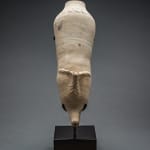Terracotta zoomorphic rhyton, 800 CE - 1200 CE
Terracotta
height 34.7 cm
height 13 5/8 in
height 13 5/8 in
SF.062
Further images
This rhyton was made on the wheel and its surface is uniformly covered with a beige light-brown slip, giving to the vessel a carefully smooth appearance. The figure represented here...
This rhyton was made on the wheel and its surface is uniformly covered with a beige light-brown slip, giving to the vessel a carefully smooth appearance.
The figure represented here is only generically zoomorphic: it is, in fact, an abstract and indefinable animal, characterized by an elongated shaped body and an equally elongated snout.
The decoration is limited to a series of linear undulating incisions and a number of dot-like circular impressions that emphasize the various parts of the body, without being specifically linked to the anatomy, made before the firing process on the still soft clay. Stylistically, this rhyton belongs to a type of ceramics widely spread on the the area of Central Asia between the last centuries of the 1st millennium AD. Along with many forms of containers such as bowls, beaker jugs or pyxides, contemporary potters have produced an extensive range of zoomorphic vessels. They are most often rhyta, vaguely corresponding to birds or horned quadrupeds, which were probably used during different rituals. Despite a certain stylistic and formal naivety, they are a very good example of the creativity and skill of artists at that time. The neck-opening on the back allowed the introduction of liquid that would then be poured out through the mouth: this type of vessel was used in cultic ceremonies to perform libations in honor of the gods.
Offerings would have once been poured in to the vessel through the largest circular opening at the back, or it may have been submerged within liquid until full. The nose contains one small nostril hole, from which the liquid would then be slowly poured as the vessel was tipped. The exact context in which these rhyta were used remains a mystery, but ancient texts suggest they would have played an important part in temple rituals. They have been found in archaeological contexts from Ancient Greece through to Asia, testament to their ceremonial importance. Their origins date back to the Neolithic period, more particularly at Hacilar in Anatolia, c. 6000 BC, evidence of the early beginnings of a tradition that would develop through succeeding periods to reach its apogee in Cappadocia, especially at Kültepe - the ancient Kanesh - in the Early Bronze Age III. Such zoomorphic rhyta are also found during the Early Bronze Age III (2300-1750 BC), distributed across a relatively broad area extending from Crete to the Balkans and including Anatolia, though they seem to be absent from Mesopotamia.
This extremely elegant abstract terracotta piece testifies to the refinement of Central Asia civilization at that time, a region rich in raw materials, particularly in copper, gold, and silver, became prosperous through the activities of merchants who established themselves in settlements, on the outskirts of the cities.
The figure represented here is only generically zoomorphic: it is, in fact, an abstract and indefinable animal, characterized by an elongated shaped body and an equally elongated snout.
The decoration is limited to a series of linear undulating incisions and a number of dot-like circular impressions that emphasize the various parts of the body, without being specifically linked to the anatomy, made before the firing process on the still soft clay. Stylistically, this rhyton belongs to a type of ceramics widely spread on the the area of Central Asia between the last centuries of the 1st millennium AD. Along with many forms of containers such as bowls, beaker jugs or pyxides, contemporary potters have produced an extensive range of zoomorphic vessels. They are most often rhyta, vaguely corresponding to birds or horned quadrupeds, which were probably used during different rituals. Despite a certain stylistic and formal naivety, they are a very good example of the creativity and skill of artists at that time. The neck-opening on the back allowed the introduction of liquid that would then be poured out through the mouth: this type of vessel was used in cultic ceremonies to perform libations in honor of the gods.
Offerings would have once been poured in to the vessel through the largest circular opening at the back, or it may have been submerged within liquid until full. The nose contains one small nostril hole, from which the liquid would then be slowly poured as the vessel was tipped. The exact context in which these rhyta were used remains a mystery, but ancient texts suggest they would have played an important part in temple rituals. They have been found in archaeological contexts from Ancient Greece through to Asia, testament to their ceremonial importance. Their origins date back to the Neolithic period, more particularly at Hacilar in Anatolia, c. 6000 BC, evidence of the early beginnings of a tradition that would develop through succeeding periods to reach its apogee in Cappadocia, especially at Kültepe - the ancient Kanesh - in the Early Bronze Age III. Such zoomorphic rhyta are also found during the Early Bronze Age III (2300-1750 BC), distributed across a relatively broad area extending from Crete to the Balkans and including Anatolia, though they seem to be absent from Mesopotamia.
This extremely elegant abstract terracotta piece testifies to the refinement of Central Asia civilization at that time, a region rich in raw materials, particularly in copper, gold, and silver, became prosperous through the activities of merchants who established themselves in settlements, on the outskirts of the cities.





